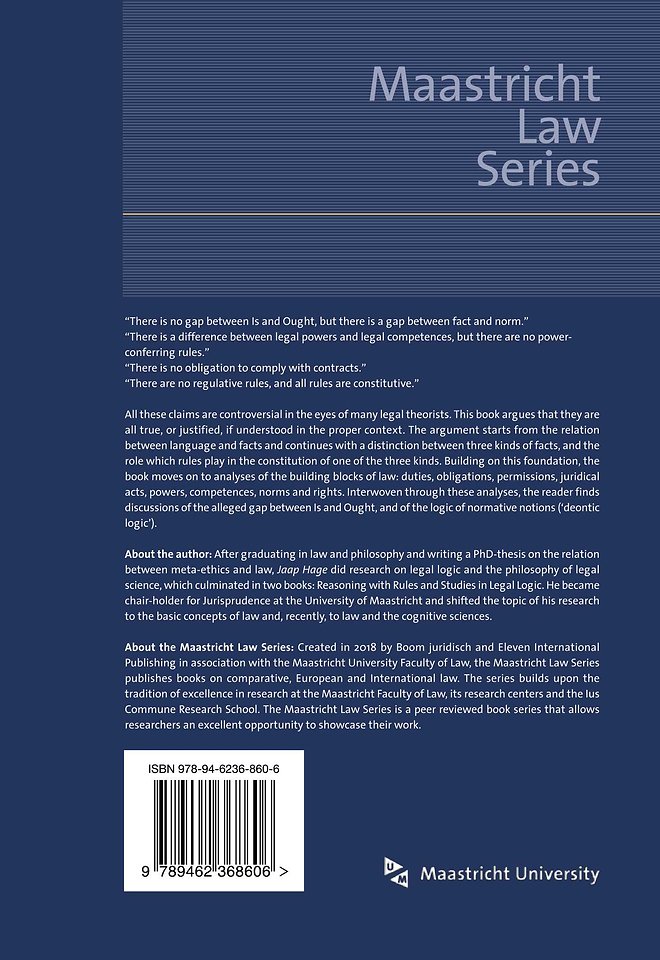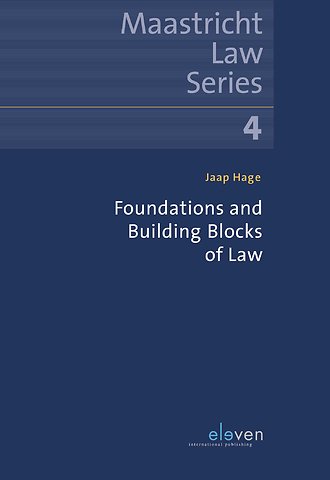



Jaap Hage is Professor of Jurisprudence at Maastricht University and Fellow of the Maastricht European Private Law Institute (M-EPLI), Maastricht University.
Meer over Jaap HageFoundations and Building Blocks of Law
(PDF-Download)
Samenvatting
“There is no gap between Is and Ought, but there is a gap between fact and norm.”
“There is a difference between legal powers and legal competences, but there are no power-conferring rules.”
“There is no obligation to comply with contracts.”
“There are no regulative rules, and all rules are constitutive.”
All these claims are controversial in the eyes of many legal theorists. This book argues that they are all true, or justified, if understood in the proper context. The argument starts from the relation between language and facts and continues with a distinction between three kinds of facts, and the role which rules play in the constitution of one of the three kinds. Building on this foundation, the book moves on to analyses of the building blocks of law: duties, obligations, permissions, juridical acts, powers, competences, norms and rights. Interwoven through these analyses, the reader finds discussions of the alleged gap between Is and Ought, and of the logic of normative notions (‘deontic logic’).
Trefwoorden
Specificaties
Inhoudsopgave
1 The normativity of law 2
2 Kelsen: the legal ought, validity and efficacy 4
2.1 The ambiguity of the legal ought 4
2.2 How norms exist 6
2.3 The role of efficacy 7
2.4 Summary on Kelsen 9
3 Ross: validity as projection 10
3.1 The antinomies 10
3.2 Projectivism 12
3.3 Concluding remarks on Ross 15
4 Hart and the internal aspect of rules 15
4.1 Austin: the ban of normativity 15
4.2 Being obliged and having an obligation 16
4.3 The internal aspect of rules 16
4.4 Concluding remarks on Hart 18
5 Legal powers 18
5.1 Hart on power-conferring rules 18
5.2 Only private powers? 19
5.3 Exercise of power through invocation of rules 20
5.4 Duty-imposing rules and power-conferring rules 21
5.5 Conclusion on powers 22
6 Rights 22
7 Reconstruction and construction 24
7.1 Legal reasoning as reconstruction 24
7.2 Legal constructivism and the institutional theory of law 25
7.3 Dworkin’s criticism of Hart 26
8 Looking forward 27
Part A FOUNDATIONS 29
II. MEANING 31
1 Language and the world 31
1.1 Law as institutional fact 31
1.2 Facts 32
1.3 States of affairs 33
1.4 Terms and individuals 34
2 The meaning of the world 35
2.1 Personal meaning 36
2.2 Social, conventional and rule-based meaning 37
2.3 Contingent and inherent meaning 39
2.4 Searle on function 40
2.5 Occam’s razor 42
3 Linguistic meaning 43
3.1 Criteria theories of meaning 44
3.2 Stereotypes or ideal types 46
3.3 Theories of direct denotation 46
3.4 Inferential analysis of meaning 49
3.5 Legal status words 51
4 Internal and external concepts 52
5 Closed and open generalisations 53
6 Conclusion 55
III. Rules as constraints 57
1 Not all rules guide behaviour 57
2 Directions of fit 59
3 Possible worlds and necessity 62
3.1 Possible worlds 62
3.2 Propositional logic 63
3.3 Necessity and the world-to-word direction of fit of constraints 65
3.4 Conditionals and counterfactuals 65
4 Rules as constraints on possible worlds 67
4.1 Soft constraints 68
4.2 Factual and descriptive counterparts of rules 69
5 Conclusion 69
IV. FACTS 71
1 Objective and subjective 71
1.1 The traditional view 72
1.2 The phenomenological view 73
1.3 Peeling off subjectivity 75
1.4 The social construction of reality 77
2 Objective and other kinds of facts 78
2.1 Kinds of facts 78
2.2 Objective facts 80
2.3 Objectivity and language 81
3 Brute social facts 82
4 Mountain hikers 84
5 Social rules and efficacy 85
6 Rule-based facts 86
7 Rule-based rules 87
8 Conclusion 88
Part B BUILDING BLOCKS 91
V. KINDS OF RULES 93
1 Introduction and overview 93
2 Dynamic rules 94
2.1 Introduction to dynamic rules 94
2.2 Kelsen on static and dynamic normative systems 95
2.3 Searle’s ‘derivation’ of Ought from Is 97
2.4 Contracts and legal positions 98
2.5 No obligation to comply with contracts 99
2.6 Logical analysis of contracts 100
2.7 The lesson to be learned 102
3 Counts-as rules 102
3.1 Introducing counts-as rules 102
3.2 Simple classification 104
3.3 Events 104
3.4 The attribution of legal status 106
3.5 Evaluation 107
3.6 Rules of change and rules of recognition 108
3.7 Counts-as rules and constitutive rules 109
4 Fact-to-fact rules 111
4.1 Duty-imposing rules 111
4.2 Rules that confer competences 113
4.3 Rules that grant rights 113
4.4 Sovereignty as example of legal status 114
5 The interaction of rules; an elaborate example 115
6 Conclusion 117
VI. ELEMENTARY DEONTIC BUILDING BLOCKS 119
1 Deontic furniture of the world 119
2 Practical reason and deontics 121
3 Duties 123
3.1 Duties and obligations 123
3.2 What to do and how to do it 126
3.3 The origins of duties 127
3.4 Action types and tokens 129
3.5 The elements of a duty 130
3.6 Some brief remarks on formalisation* 132
3.7 Formalisation* 133
3.8 Some logical characteristics of duties* 134
4 Obligations 136
4.1 The sources of obligations 136
4.2 The elements of an obligation 136
4.3 Formalisation* 137
4.4 Some logical characteristics of obligations* 138
VII. DERIVED DEONTIC BUILDING BLOCKS 141
1 Being obligated 141
1.1 Being obliged and must do 141
1.2 Duties, obligations and being obligated* 143
1.3 The elements of being obligated* 144
1.4 Some logical characteristics of being obligated* 145
1.5 Deontic inheritance 146
1.6 Formalisation of deontic inheritance* 147
2 Ought 148
2.1 Prima facie and all-things-considered 148
2.2 All ought is pro tanto 149
2.3 Duties, obligations, ought-to-do and reasons for action* 151
2.4 Some logical characteristics of ought-to-do* 152
3 Permission 155
3.1 Weak permission of action types 156
3.2 Strong permissions of action types and freedom rights 157
3.3 Formalisation* 158
3.4 Permission of action tokens 159
3.5 Logical analysis* 160
4 Conclusion 162
VIII. THE NATURE OF NORMS 165
1 Introduction 165
2 Two conceptions of norms 166
3 The semantic conception of norms 166
4 Norm-propositions 167
5 The pragmatic conception of norms 170
6 The world-to-word direction of fit of constraints 172
7 Can there be a logic of norms? 173
8 Application 174
IX. THE NORMATIVITY OF LAW 177
1 Introduction 177
2 The Is/Ought gap 177
2.1 The Ought as separate sphere by definition 178
2.2 Some examples 180
2.3 Descriptive sentences and the sphere of Is 181
2.4 Rules as bridges 182
2.5 Existence of deontic facts as being accepted 183
2.6 Addendum for logicians* 186
2.8 Conclusion on the Is/Ought gap 187
3 The fact/norm distinction 188
4 The normativity of law 190
4.1 Introduction 190
4.2 Kelsen’s views revisited 190
4.3 The internal point of view 192
4.4 Conclusion on the normativity of law 194
X. JURIDICAL ACTS 195
1 Actions, basic and expanded 196
2 Legal powers 199
3 The rules that underlie legal powers 200
3.1 Counts-as rules 200
3.2 Fact-to-fact rules 201
3.3 Dynamic rules 201
4 What is special about juridical acts? 202
5 The validity and consequences of a juridical act 204
5.1 Counts-as rules 204
5.2 Competence 205
5.3 Legislation as example 206
6 Validity, nullity and avoidance 207
7 Competence, capacity and power 209
8 Discussion 212
8.1 Bentham 212
8.2 Atienza and Manero 213
8.3 Hart: nullity as sanction 214
8.4 Spaak on competence 216
9 Conclusion 218
XI. APPLICATIONS AND ELABORATIONS 221
1 The validity of rules and their sources 221
1.1 Kelsen: validity as binding force 221
1.2 Internal validity-claims 222
1.3 External validity claims; validity as efficacy 225
1.4 Conclusion on validity 226
2 The Hohfeldian concepts 227
2.1 Hohfeld’s purpose 227
2.2 Hohfeld’s basic analysis; the claim-cluster 228
2.3 Formalisation of the claim-cluster* 229
2.4 Hohfeld’s basic analysis; the power-cluster* 230
2.5 Are Hohfeld’s concepts comprehensive? 231
2.6 Are Hohfeld’s concepts basic? The claim-cluster 233
2.7 Are Hohfeld’s concepts basic? The power-cluster 234
2.8 Conclusion on the Hohfeldian conceptual framework 236
3 Rights 237
3.1 Rights and status 237
3.2 Kinds of rights* 238
4 How to leave the law? 240
4.1 Kelsen on sanctions 240
4.2 The transition from law to the outside world 241
XII. CONCLUSION 243
LITERATURE REFERENCES 247
INDEX OF SUBJECTS 263
INDEX OF NAMES 269
Anderen die dit e-book kochten, kochten ook
Rubrieken
- cadeauboeken
- computer en informatica
- economie
- filosofie
- flora en fauna
- geneeskunde
- geschiedenis
- gezondheid
- jeugd
- juridisch
- koken en eten
- kunst en cultuur
- literatuur en romans
- mens en maatschappij
- naslagwerken
- non-fictie informatief/professioneel
- paramedisch
- psychologie
- reizen
- religie
- schoolboeken
- spiritualiteit
- sport, hobby, lifestyle
- thrillers en spanning
- wetenschap en techniek
- woordenboeken en taal





